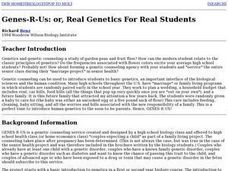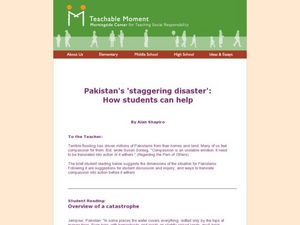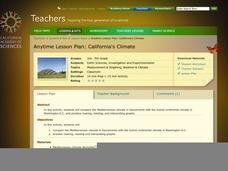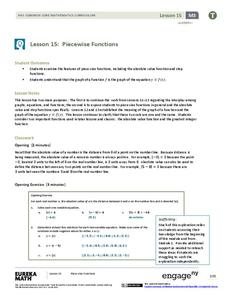Curated OER
Teachers.Net Lesson Exchange: Classroom Objects (other, other
Students study the names of classroom objects, then examine their cards and read the information silently and very carefully.
Curated OER
Trekking to Timbuktu: Timbuktu: A Center of Trade - Teacher Version
Fourth graders discuss the origins of Timbuktu, explain the importance of its location, and describe the kingdom of Mali. They also explain how and why Timbuktu became a part of Mali.
Curated OER
Children's March Teacher's Guide, Activity 6
Learners explore the role of gender in the Civil Rights Movement. In this Children's March instructional activity, students watch "Mighty Time: The Children's March" and respond to the provided discussion questions that accompany it....
Curated OER
Hierarchical Organization in Biology: Students Presentations of Neurobiology
Students gather (research) information on neuron structure and action potential. Students are guided to make inferences about the synapse and its relationship to neurotransmitter release and action. They are also guided to make...
Curated OER
Action Potential: A Student Project
High schoolers demonstrate their knowledge of action potential by creating an analogy and explaining this analogy to the class. They illustrate the action potential on paper by creating an analogy to demonstrate action potential and...
Curated OER
Watching the Clock: An activity to build media-savvy students
Students analyze time constraints on broadcast news. They apply data collecting and data display skills. They identify the difference between news progams and the evening news.
Curated OER
Genes-R-Us: or, Real Genetics For Real Students
Students explore genetics and genetic counseling. They research information on human genetic disorders. Students simulate developing a complete counseling service to assist the community.
Curated OER
Portraits of the Seven Deai Students
Students are introduced to the seven "Deai" students. They discover more about themselves and their classmates and cultivate empathy with their peers. Students assume the role of their Deai student and present their "self-introduction."
Curated OER
Students Get Animated: Make Existing Lessons Move and Motivate Students
Students study the chemical elements in a computer generated cartoon format. In this computer animation and chemistry lesson, students learn how to animate using computer programs. Students use animation to learn about the Periodic Table...
Curated OER
Individualized Lesson for Student C
Pupils explain how to solve an algebraic word problem using correct grammar and punctuation. In this math and writing lesson, students are given a word problem and must write down directions to solve it.
Curated OER
Pakistan's 'Staggering Disaster': How Students Can Help
Students explore the effects of massive flooding in Pakistan. In this global issues instructional activity, students read an article about monsoons and flooding in Pakistan. Students respond to discussion questions based on the article.
Curated OER
Latin Tutorial 1: Multiple-Choice Item Writing for Teachers
What are the benefits to providing your learners with multiple-choice questions on quizzes and tests? If you'll be teaching Latin literature this year, read this quick argument to decide which types of questions you'll create.
Curated OER
Hermeneutics: Teaching Students Author's Purpose
Your developing literary critics discuss 'perspective' and discuss how the same occurence can be interpreted by two different people in two different ways. They read Ryszard Kapuscinski's untitled poem, infer meaning of the poem, and...
Curated OER
Research Projects in Renewable Energy for High School Students
Thirty-eight pages of information prepares you to assign middle or high schoolers a project on sustainable energy. They take a pretest, review the scientific method, conduct background research, and finally choose an experiment to carry...
Curated OER
Applying KWL Guides to Sources with Elementary Students
What is a KWL chart? Here is a well thought-out lesson that has learners use KWL charts to gain historical perspective. Your class examines primary sources about historical events and identifies what they know, want to know, and,...
EngageNY
Construct a Perpendicular Bisector
How hard can it be to split something in half? Learners investigate how previously learned concepts from angle bisectors can be used to develop ways to construct perpendicular bisectors. The resource also covers constructing a...
EngageNY
Bacteria and Exponential Growth
It's scary how fast bacteria can grow — exponentially. Class members solve exponential equations, including those modeling bacteria and population growth. Lesson emphasizes numerical approaches rather than graphical or algebraic.
Curated OER
Improving Students' Writing Skills
Are your writers making the same mistakes over and over again? Instead of editing their papers, consider encouraging learners to use this sheet to classify their errors. This helps them identify and address common problem areas they...
California Academy of Science
California's Climate
The United States is a large country with many different climates. Graph and analyze temperature and rainfall data for Sacramento and Washington DC as you teach your class about the characteristics of Mediterranean climates. Discuss the...
EngageNY
Piecewise Functions
Show your class members that if they can graph a linear function, they can graph an absolute value function. Groups create an absolute value graph using a table, then entertain the idea of an absolute value function defined as two pieces...
EngageNY
Four Interesting Transformations of Functions (Part 3)
Continue the study of transformations with an examination of horizontal stretches, shrinks, and reflections. Individuals use the same process used in parts one and two of this series to examine horizontal changes. The resource also...
EngageNY
Advanced Factoring Strategies for Quadratic Expressions (part 1)
Factoring doesn't have to be intimidating. Build on prior knowledge of multiplying binomials and factoring simple trinomials to teach advanced factoring of quadratic expressions with a activity that uses various methods of exploring the...
EngageNY
Using the Quadratic Formula
What is the connection between the quadratic formula and the types of solutions of a quadratic equation? Guide young mathematicians through this discovery as they use the discriminant to determine the number and types of solutions, and...
EngageNY
The Graph of the Equation y = f(x)
Math language? Set notation is used in mathematics to communicate a process and that the same process can be represented as computer code. The concept to the loop in computer code models the approach pupils take when creating a solution...
Other popular searches
- Student Teacher Observation
- Student Teacher Cpr
- Student Teacher Relation
- Student Teacher Lesson Plans
- Student Teacher Reports
- Student Teacher Relationship
- Student Teacher Technique
- Student Teacher Japan
- Student Teacher 92625
- Mentoring Student Teachers

























